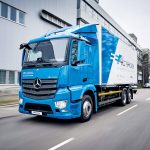Death to the trucker’s American Dream

Despite the boom in the American economy and its transport industry, and healthy growth expected in 2018, progress may be held back, due to the lack of truck drivers. Automated vehicles could be the solution, but will leave 1,7 million truck drivers without jobs. FOCUS investigates.
The United States (US) economy is slowly climbing back to a healthy growth in gross domestic product (GDP). Patricia Cohenjan, journalist for the New York Times, reports that the US economy grew by 2,6 percent in 2017. According to Heather Long from the Washington Post, a similar growth of 2,7 percent is expected in 2018.
This boom has also positively impacted the original equipment manufacturers (OEMs) and the trucking industry. According to the news site Trucks.com, the sales of heavy commercial vehicles grew by 59 percent in 2017 and 196 000 jobs were created in the manufacturing industry – an increase of 1,6 percent.
The healthy growth predicted in the trucking industry might, however, be limited, due to the shortage of truck drivers. WSLS 10, a US news channel, reports that roughly 900 000 new drivers will be needed over the next decade to meet the industry demand. Companies are paying large salaries to retain drivers.
A starting salary for an American truck driver ranges from US$ 35 000 (R417 030) to US$ 40 000 (R476 656) a year with long-haul drivers earning even more. There is a good reason for these high salaries.
The US Department of Labour states that drivers of heavy vehicles have some of the highest rates of injuries and illnesses. Automated vehicles would reduce the number of injuries and lives lost in the transport industry.
The shortage of drivers is aggravated by laws that limit their working hours. Since December 18, 2017, commercial drivers have been required to use an electronic logging device (ELD) to record the number of hours they work, reports The Economic Times. Drivers are limited to 70 hours of work per week with around 11 hours of driving per day.
Transport Topics quotes Seth Owens, a lead instructor for the St Louis Community College, which offers various truck driving programmes. Owens says: “Companies can’t cook the books, so it takes more drivers and more trucks to move the same amount of freight.”
With a shortage of drivers, and high salaries paid to existing drivers, it is no surprise that the industry and President Donald Trump are pushing for the introduction of automated vehicles.
Rolling Stone magazine reports that there is a “gold rush” taking place that will disrupt the US trucking industry, which is estimated to be worth US$ 700 billion (R8,3 trillion).
Many OEMs operating in the US, including Volvo and Daimler, are already testing platooning. Tesla introduced its semi-automated Tesla Semi in 2017, which is expected to run in 2019 with PepsiCo, Anheuser-Busch and Walmart (among others) reserving nearly 300 trucks.
These truck platoons and automated trucks offer big cost saving for the US transport industry. Rolling Stone reports that “each trailing rig uses ten percent less fuel”. Automated trucks will provide safer highways, reduce emissions and transport goods at a lower cost.
Companies will eventually also shed costly truck drivers completely. Rolling Stone quotes Anthony Levandowski, Uber’s former top automation engineer: “[Eventually], none of the new trucks will have a cab on them.”
Automation might take a while to completely eradicate truck drivers – or will it? In 2016, Otto, an Uber subsidiary, ran an automated truck pilot for about 193 km. There was one driver on board in the sleeper berth. The pilot ran without an incident and when the vehicle needed to exit the highway, the onboard driver took control.
The automated vehicle used an aftermarket kit to automate an existing diesel truck, which showed that it might not be necessary for the industry to wait for OEMs to build automated vehicles. While Otto and Uber are currently in legal battles with Google, this is only the beginning with numerous other automated innovations popping up.
The mining industry is a particularly good indication of current automated innovations, with many mines already completely (or largely) automated. Rio Tinto, for example, has automated rigs running 24-hours a day (see FOCUS issue 4 of 2017).
Automated trucks will also reduce travel time by eliminating the obiligatory resting time for truck drivers. Peterbilt, a US OEM, added enough diesel capacity to its test trucks to run for 48 hours, which no truck driver would be able to do.
For many US truck drivers, there is no business quite like trucking. Rolling Stone quotes Louis Pribble, who has been a truck driver for 30-odd years: “Trucking is better money than any other job out there.”
Trucking is currently the most common profession in 29 states of America. Automated vehicles will mean the loss of 1,7 million jobs, according to a White House analysis. Rolling Stone reports that the International Transport Forum predicts a million drivers of heavy trucks will lose their jobs by 2025, while McKinsey Global Institute expects 85 percent automation and nearly 1,5 million job losses by 2027.
As the majority of American truck drivers are older men with no tertiary education, it is safe to assume that many of them will not find alternative employment – at least not a job that pays as well.
However, not everyone believes robotics will replace the truck driver. Pribble, as quoted by Rolling Stone, says: “Everybody is all worked up about it. I’d like to see that driverless truck put chains on. I’d like to see that driverless truck in snow.”
Even if automation does occur, Pribble is positive he will not be here to see it. He notes: “By the time we get to the George Jetson era, I’ll be long retired; probably dead.”
Yet, despite what truck drivers like Pribble would like to believe, automation is on its way – and fast.
Published by
Focus on Transport
focusmagsa




